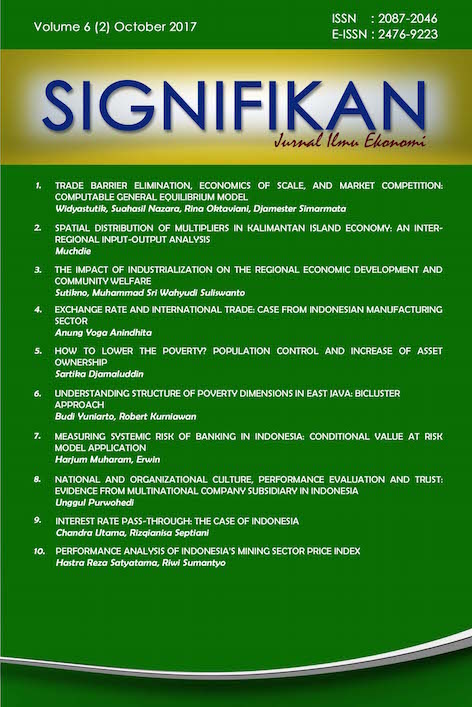Understanding Structure of Poverty Dimensions in East Java: Bicluster Approach
DOI:
https://doi.org/10.15408/sjie.v6i2.4769Keywords:
poverty, multidimensional poverty, biclusteringAbstract
Poverty is still become a main problem for Indonesia, where recently, the view point of poverty is not just from income or consumption, but it’s defined multidimensionally. The understanding of the structure of multidimensional poverty is essential to government to develop policies for poverty reduction. This paper aims to describe the structure of poverty in East Java by using variables forming the dimensions of poverty and to investigate any clustering patterns in the region of East Java with considering the poverty variables using biclustering method. Biclustering is an unsupervised technique in data mining where we are grouping scalars from the two-dimensional matrix. Using bicluster analysis, we found two bicluster where each bicluster has different characteristics.
References
Adi, I. R. (2005). Kemiskinan Multidimensi (Multidimensional Poverty). Makara seri Sosial Humaniora, 9(1): 91-100.
Badan Pusat Statistik. (2016). Penghitungan dan Analisis Kemiskinan Makro Indonesia 2016 (Measurement and Analysis of Indonesian Macro Poverty 2016). Jakarta: Badan Pusat Statistik.
Bozdag, D., A.S. Kumar., & U.V.Catalyurek. (2010). Comparative analysis of biclustering algorithms. Proceedings of the First ACM International Conference on Bioinformatics and Computational Biology. New York.
Budyantoro, S., V. Fanggidae., W. Saputra., A. Maftuchan., & D.R. Artha. (2013). Multidimensional Poverty Index (MPI): Konsep dan Pengukurannya di Indonesia (Multidimensional Poverty Indes: Concept and Measurement in Indonesia). PRAKARSA Economic Working Paper. Jakarta: PRAKARSA.
Cheng, Y., & G.M. Church. (2000). Biclustering of expression data. ISMB-00 Proceedings (pp. 93 - 103). International Conference on Intelligent Systems for Molecular Biology.
Citro, C. F. (1995). Measuring Poverty: A New Approach. Washington DC: National Academic Press.
De Troyer, E. & O. Martin. (n.d.). RcmdrPlugin.BiclustGUI: ‘Rcmdr’ Plug-in for Biclustering. R package version 1.0.6. Retrieved from CRAN: https://CRAN.R-project.org/package=RcmdrPlugin.BiclustGUI.
Gangga, A., & B.W. Otok. (2013). Pemodelan Kemiskinan di Jawa Timur dengan Structural Equation Model – Partial Least Square (Poverty Modelling in East Java Using Structural Equation Model-Partial Least Square). Statistika, 1(2): 121-130.
Junaidi, Z., D. Wisadirana., & S. Kanto. (2015). Analisis Determinan Kemiskinan di Jawa Timur (Determinant Analysis of Poverty in East Java). Wacana, 18(1), 41-50.
Manurung, F. A., & D.B. Santoso. (2015). Pemetaan Kemiskinan Kabupaten/Kota di Provinsi Jawa Timur (Poverty Mapping of District in East Java). Working Paper. Malang: Universitas Brawijaya.
Mina, E. (2010). Applying Biclustering to understand the molecular basis of phenotypic diversity. (Unpublished Thesis). Utrecht: Utrecht University.
Narayan, D., R. Patel., K. Schafft., A. Rademacer., & S. Koh-Schulte. (1999). Can Anyone Hear Us? Voices from 47 Countries. Poverty Group, PREM. World Bank.
Sabiti, M.B. & J. Effendi. (2017). Islamic Microfinance and Its Impact on Poverty Reduction of Two Village Models in Bogor, Indonesia. Signifikan: Jurnal Ilmu EKonomi. Vol. 6 (1): 87-102.
Sen, A. (1980). Equality of What? McMurrin S Tanner Lectures on Human Values, 1.
Sen, A. (1999). Development as Freedom. Oxford: Oxford University Press.
Wagle, U. (2005, November). Multidimensional Poverty Measurement with Economic Well-being, Capability, and Social Inclusion: A Case from Kathmandu, Nepal. Journal of Human Development, 6(3): 321-330.
World Bank Institute. (2002). Dasar-dasar Analisis Kemiskinan (The Basics of Poverty Analysis). Edisi Terjemahan. Jakarta: Badan Pusat Statistik.
Yuniarto, B., & Kurniawan, R. (2017). Modified multiblock partial least squares path modeling algorithm with backpropagation neural networks approach. Statisticts and its Applications: Proceedings of the 2nd International Conference on Applied Statistics (ICAS II), 2016. 1827. AIP Publishing.

